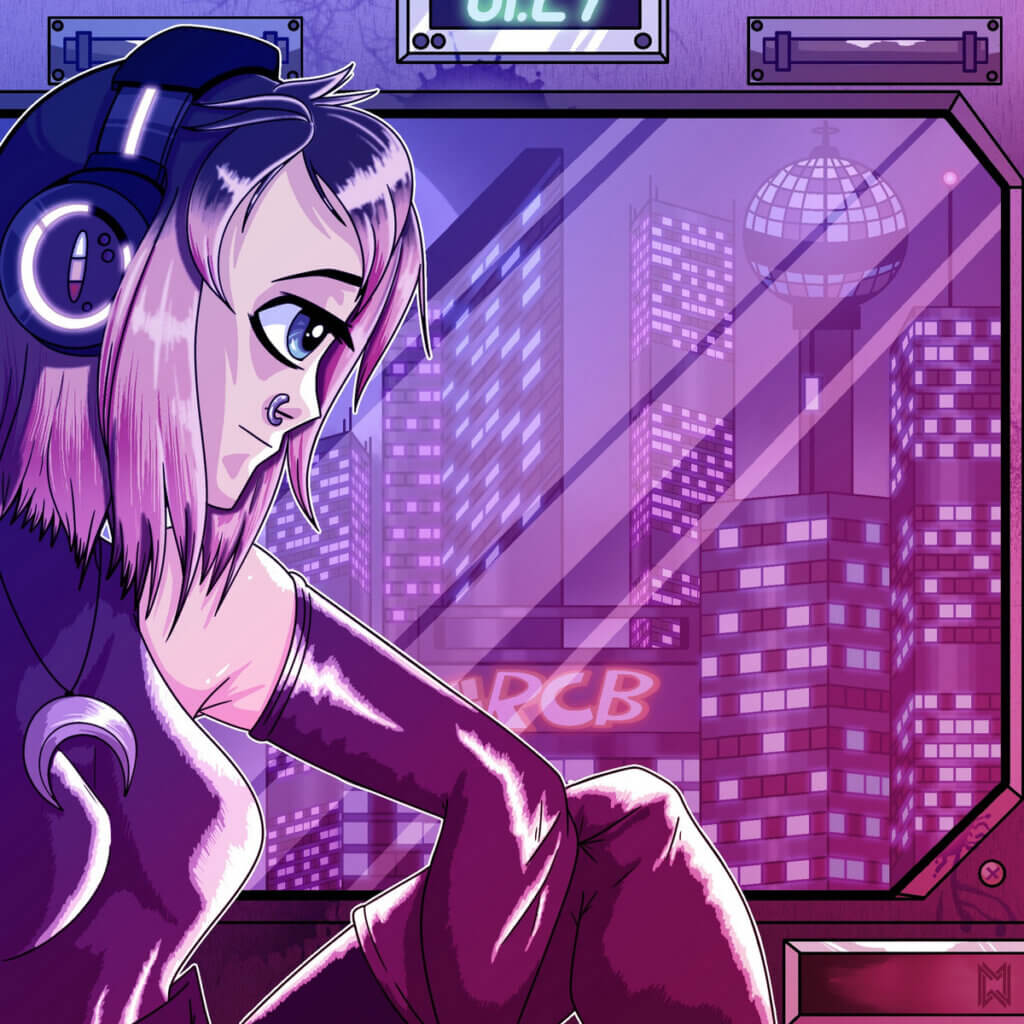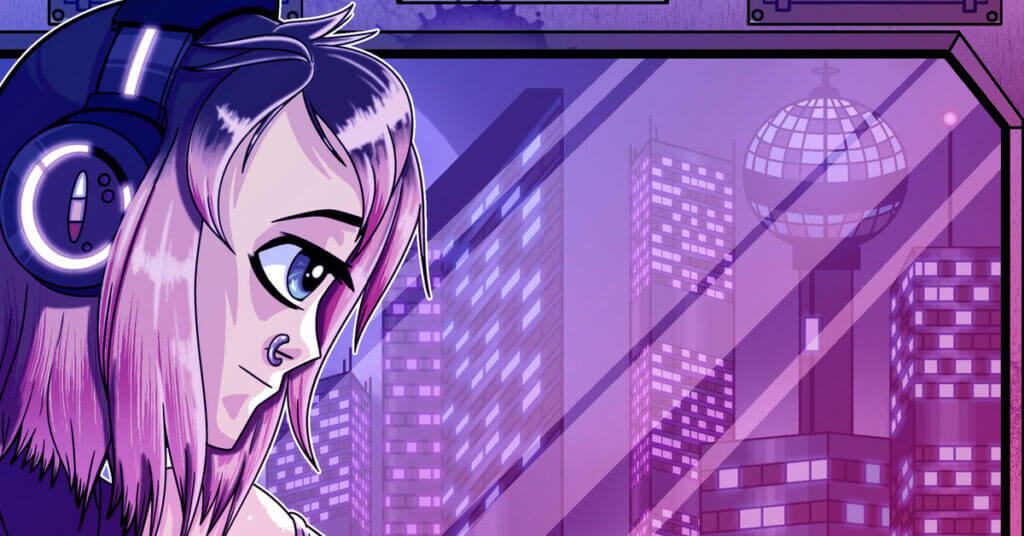On her latest album, In a Weary World, Megan McDuffee taps into something special. You can call it synthwave if you want, but that’s really a disservice to this fantastic album. Don’t get me wrong, I love synthwave music but a lot of it doesn’t sound dissimilar to late 80s/early 90s EBM or synth-pop. And I suppose that is exactly the appeal for a lot of people, and I get it. Synthwave is huge right now, and has been for the last few years. So much so that there are as many varieties of it as there are of other styles of electronic music. The synthwave music that I tend to gravitate to though is the slower, more prodding, more cinematic-sounding stuff. The stuff that emulates 80s movie soundtracks, essentially. That’s a bit closer to what we have here.
I grew up listening to electronic music. It’s one of the things that lead me down the “path of cyberpunkery” from an early age. It always appealed to me, even as a young child. Growing up in the 80s and 90s, music was such a commonplace thing and so integrated into culture and society that it almost seemed kind of mundane. But it was electronic music that, whenever I heard it, piqued my interest in not only the music itself, but whatever media was associated with it. I’m not sure why. It might be my love of computer technology from a young age. Or it might’ve been my love of science fiction, also from a young age. But something about music being composed with technology appealed to me on a deeper level than traditional music ever did.
In the 80s, electronic music was fairly prevalent for a variety of reasons. I imagine one of those reasons was the mass marketing and consumerism surrounding synthesizers. New wave music was getting really big and every band had to have a synth/keyboard player. At least one. Sometimes many more. So I imagine the market for synthesizers blew up as a result of every high school kid wanting to start a band and be the next new wave phenomenon.
Another major reason was movies. Electronic music scores certainly didn’t start in the 80s. There was Wendy Carlos’ amazing score for A Clockwork Orange, a film that came out in 1971 and predated the 80s proliferation of electronic movie scores by far. It was, as I understand, hugely influential on it though. And rightfully so.
You could spend a whole day talking about all the 80s films that used electronic music scores and only get to a fraction of them. The reason for this is debatable. There is a likelihood that many movie producers/directors simply chose it for aesthetic effect because it fit the theme of the film perfectly. The Terminator and it’s score by Brad Fiedel is a good example here. But I suspect that there was a bigger reason that electronic scores were so prevalent in the 80s and it has to do with budgets. Often these scores were created by one single person. And it was infinitely cheaper for movie studios to hire one musician with a synthesizer to compose a score than to hire a high-profile composer and an orchestra. So I assume using synthwork was a cost-cutting measure by movie studios.
But hey, that’s ok. It’s what lead to the amazing revival of 80s movie-sounding music we have today in the 2020s known as synthwave. Thank you cheap-ass movie studios!
My exposure to electronic music owes itself to this. I watched a lot of movies as a kid in the 80s and so I experienced a lot of electronic music. There were three films in particular whose scores stood out and helped create a deep-seeded love of electronic music in me. One was the aforementioned The Terminator. But there were two more that had an even bigger, more profound impact. It should be no surprise, given the theme of this website, that one of them was Blade Runner. The other was Legend. Two very different movies by the same director, Ridley Scott. Blade Runner’s soundtrack was composed by Vangelis and Legend’s was composed by Tangerine Dream.
The music these artists composed was often referred to as “new age” by media outlets. That was unfortunate because new age music was associated with many of the fluff pseudo-religious movements of the time. I had heard new age music, and this was not that. Even as a child I knew this was not that. It was moody, yes. It was calm, yes. It was ambient, yes. But it wasn’t new age, even if the artists themselves sometimes used the term to describe their own music. It was a disservice to the brilliantly deep, creative, thought provoking electronic compositions they were creating.
These artists were actually part of a music scene known as “Berlin school” or “the Berlin school of electronic music” as many of the genre’s most prominent artists were from, or were based in, Berlin, Germany. Vangelis was more of an honorary member as he was from Greece, but created a very similar style of music. I didn’t know anything about this genre at the time though. I had no idea it even existed. I was a kid and there was no internet available to the average American household. I had to rely on music magazines that I would peruse whenever I’d visit a book or music store and glean whatever info I could. Had it not been for these films though, I sadly wouldn’t have even known these artists existed at all.
As movies got bigger and bigger, they also got bigger and bigger budgets. And eventually the synth-based score became less popular as movie studios began to favor classical “organic” scores with big grand orchestras and high-profile composers at the helm. Electronic music itself was also evolving away from the analogue modular synthesis work of the late 70s/early 80s and began adopting digital and software-based technologies in the late 80s and especially as the 90s rolled in. Modern electronica took off and Berlin school music, as it had been known, became less prevalent and more underground. The most prominent artists like the aforementioned Tangerine Dream and Vangelis, as well as others like Jean Michel-Jarre and Klaus Schulze continued to thrive but weren’t talked about much outside of electronic music enthusiast circles.
The genre wasn’t dead but it had become niche. And it would stay that way until a little revival from the 2010s to the 2020s. Some newer artists have begun adopting the old styles of Berlin school and creating a modern take on them. Arists like Neuland and Martin Stürtzer are great examples. Even bands like Apoptygma Berzerk have gone back to their modular synth roots and started writing modern music with older tech, and it’s all the better for it. Which all brings me, finally, back to Megan McDuffee and her album In a Weary World.
McDuffee has earned a name for herself for creating music for critically acclaimed video game soundtracks including Wayforward’s River City Girls series and Atari’s Recharged series of revamped classics. She’s a highly sought-after artist for video game, TV, and film projects and despite being such a prolific artist for years, she didn’t release her full length debut album until May, 2021. In a Weary World is her latest full length effort. It’s a completely instrumental album in the vein of the aforementioned Tangerine Dream, Vangelis, and Wendy Carlos. She describes the album as chillwave, a downtempo style of music often associated with synthwave.

For me, what the album really is, though, is a modern and updated take on classic Berlin school music. And it sounds like an authentic one too. I’ve said on this website before that this style of music is the unofficial sound of cyberpunk thanks to Vangelis’ score to Blade Runner. And indeed, In a Weary World is chock full of cyberpunk vibes. Every track on this album conjures up mental images of a calming journey through a futuristic cityscape at night. It’s easy to get lost in these mental images as you listen and a whole fictional cyberpunk world unfolds in your mind.
There are 9 tracks on this album with a total play time of roughly 33 minutes. Most of the tracks are ambient, though percussive elements pop up from time to time that, while not quite dance-worthy, raise the tempo up a bit. But everything stays below mid-tempo here. The beats are simple but effective. The album is relaxing and cinematic through and through. The lush, classic-sounding synthwork succeeds in sounding simultaneously retro and futuristic, which has in modern times become a staple of this genre and one of the things that I’ve come to adore about it. The dichotomy of the the two puts my head in such a delightfully unique place that I’d physically move to it and live in it if I could.
In a Weary World couldn’t be more aptly named. This was exactly the collection of music I needed to escape the stress and anxiety of life in the world of 2022. I loved every minute of this album. It’s a short but sweet collection of retro-style and modern production that took me on a journey to a delightful retro-futuristic world. This album goes on my list of important works in this genre and will be one of the soundtracks for my many cyberpunk daydreams for years to come. It checks all the boxes on the list of everything I love about this genre.
In a Weary World can be purchased on Megan McDuffee’s bandcamp page for $8. A small price to pay for a fantastic collection of music that will take you on a voyage to a much more relaxing dystopia.

